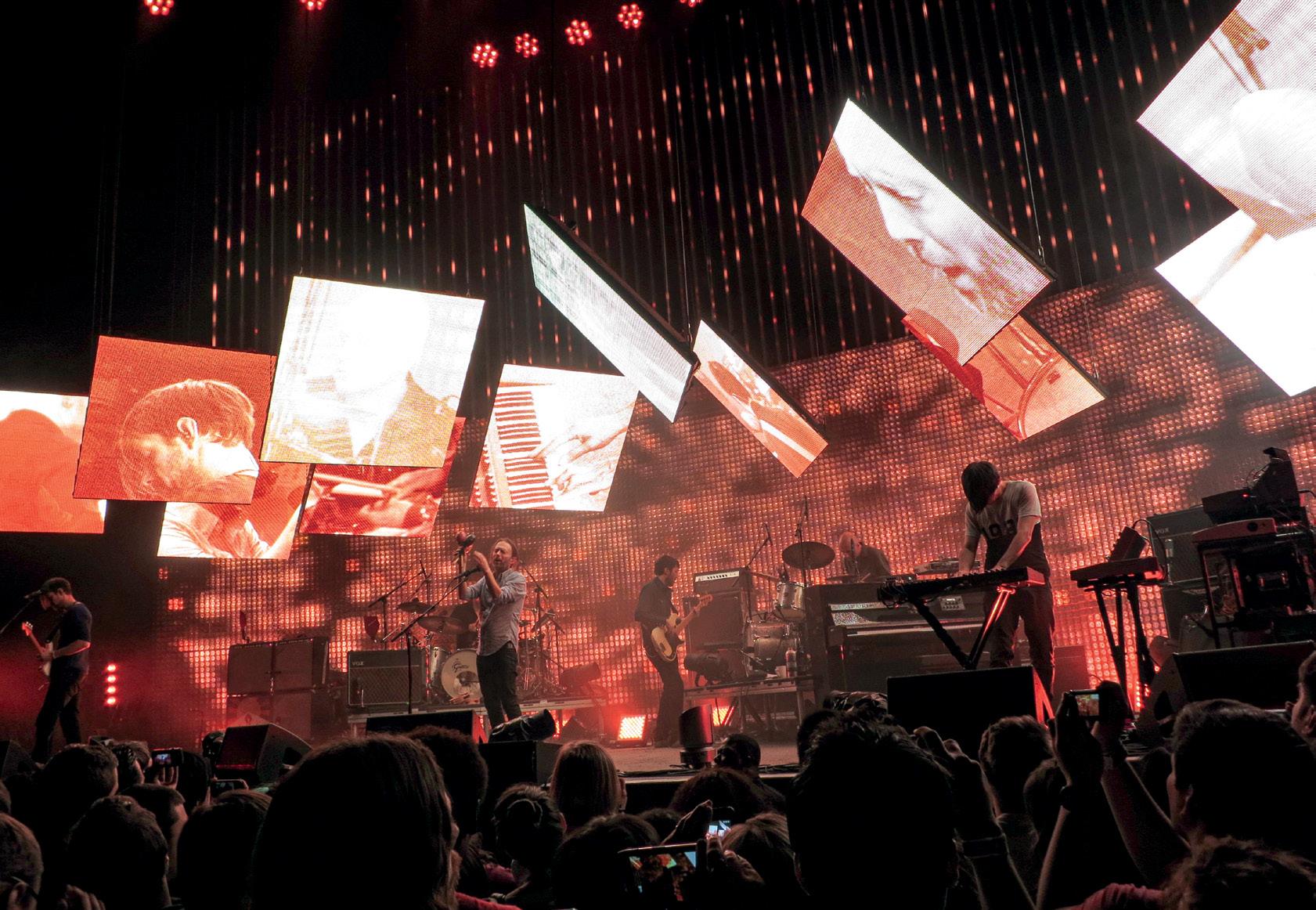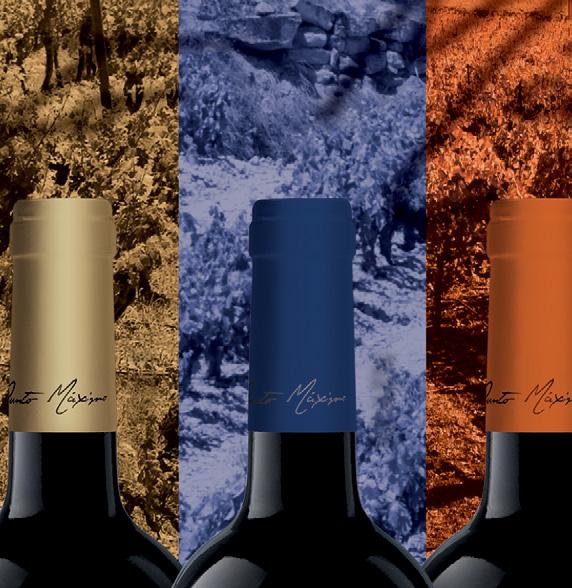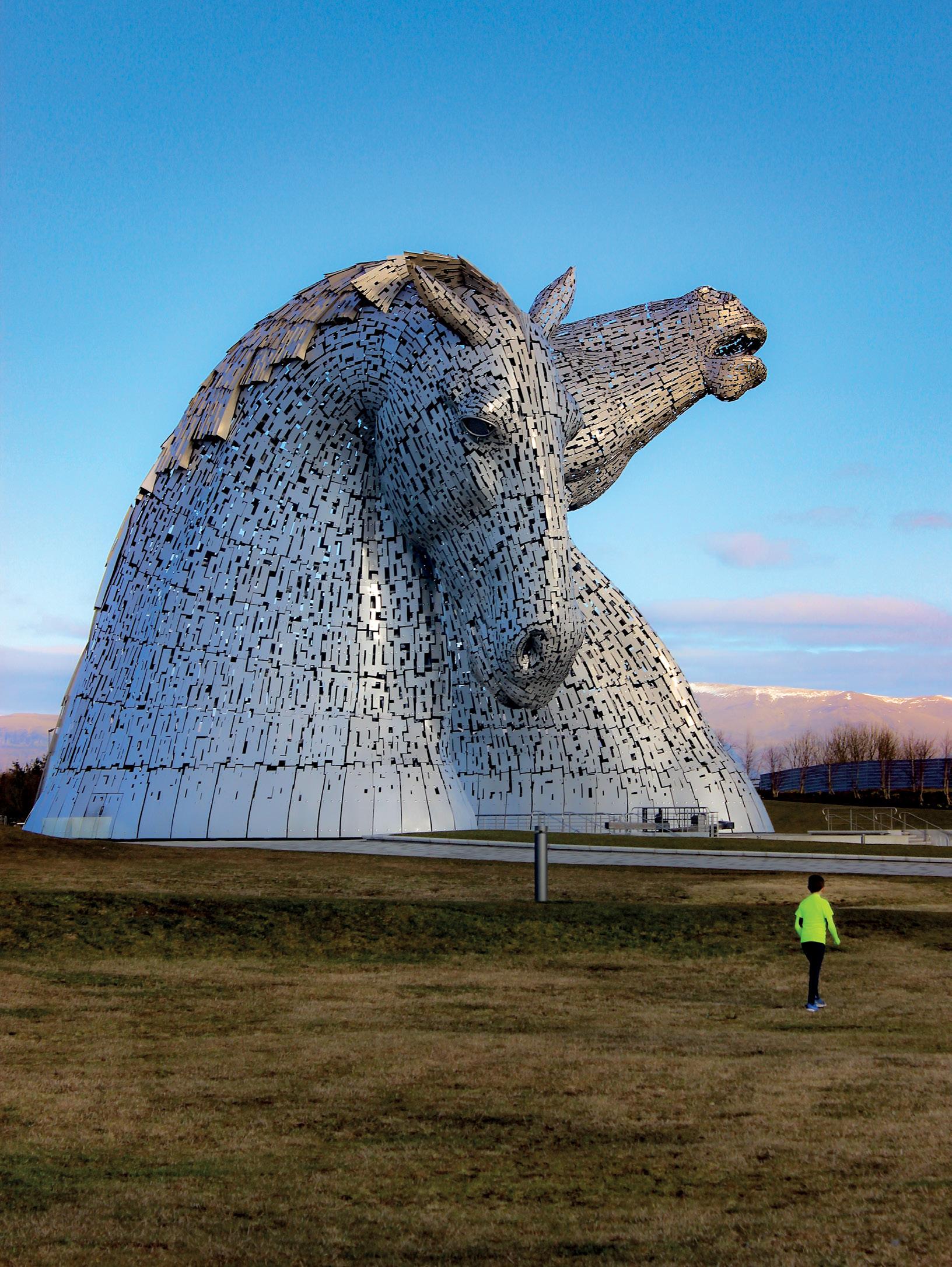
20 minute read
A banda de rock mais influente da atualidade
from Ahead mag
INEXPLICÁVEL RADIOHEAD
UNEXPLAINABLE RADIOHEAD
Advertisement
Como a banda de rock mais influente da atualidade se mantém no topo, criando discos cada vez mais experimentais e aclamados pelo público, e desafia padrões na indústria da música How today’s most influential rock band continues at the top, creating increasingly more experimental albums acclaimed by the public and challenging patterns of the music industry
ual banda de rock poderíamos chamar de a mais influente do mundo? Qual grupo ostenta letras e sons tão modernos e relevantes durante três décadas e não dá sinais de querer parar? Quem subverte padrões de comportamento na música, sem polêmicas e desavenças que levam tantas bandas de rock ao fim? Há um grupo que se encaixa em todos esses parâmetros. Ele trabalha há 34 anos em sintonia, com a formação original e, até, com o mesmo empresário. Tudo isso é Radiohead.
Em 1985, cinco rapazes que se conheceram em uma escola particular só para meninos na pequena cidade de Abingdon, Inglaterra, criaram a banda “On a Friday” — porque os ensaios na escola aconteciam só às sextas-feiras. Desde então, os meninos viraram astros da música, e a formação da banda nunca mudou. Só o nome, anos mais tarde, a pedido da gravadora EMI e inspirado na (já esquecida) música “Radio Head”, do Talking Heads.
Não fosse pelo conjunto da obra, e o Radiohead já seria objeto de estudo por manter a formação original por tanto tempo. Isso é realmente surpreendente em uma indústria onde o entusiasmo da juventude, aos poucos, dá espaço para diferenças de opinião e, consequentemente, a projetos solo. Agora, imagine que os membros do Radiohead têm gostos completamente diferentes, // What rock band could we call the world’s most influential? Which group splurges lyrics and sounds so modern and relevant for three decades, giving no sign that it wants to stop? Who subverts the patterns of behavior in music, without controversies and fights that lead so many rock bands to their end? There is one group that fits all these parameters. A group working together for 34 years in tune, with the same original formation and even the same manager. All this is Radiohead.
In 1985, five lads who met at a private school for boys only in the small city of Abingdon, England, created the band “On a Friday” – because rehearsals at school took place only on Fridays. Since then, the boys became music stars and the band’s lineup never changed. Only the name, years later, by request of their record company EMI and inspired by the (long-forgotten) song “Radio Head” by the Talking Heads.
Notwithstanding the body of work, Radiohead could be a subject of study for maintaining its original lineup for such a long time. This is really surprising in an industry where the enthusiasm of youth gradually opens the ground for differences of opinion and, consequently, solo projects. Now imagine that the members of Radiohead have completely different tastes, something that they usually joke about in their rare interviews. Besides, each member has distinct individual projects – that have never affected the band’s activities.
Picked as the 60th best guitar player of all time by Rolling Stone Magazine, Edward O’Brien takes part in the
Qpor/by Olga Kovalenko

algo sobre o que costumam brincar em suas raras entrevistas. Além disso, cada integrante tem projetos individuais distintos — e que nunca afetaram as atividades da banda.
Eleito 60º maior guitarrista de todos os tempos pela Rolling Stone, Edward O'Brien participa de gravações de trilhas sonoras para minisséries da BBC. Considerado o 26º maior baterista da história pelo site Gigwise, Philip Selway está envolvido em sessions de músicos britânicos. Enquanto isso, o baixista Colin Greenwood faz participações especiais em shows de outras bandas e seu irmão, o multi-instrumentista Jonny Greenwood (48º maior guitarrista pela Rolling Stone), acumula trilhas sonoras em filmes como “Sangue Negro” e “Trama Fantasma” (indicado ao Oscar), além de escrever complexas obras sinfônicas.
Isso sem falar em Thom Yorke, líder e alma do Radiohead: além de membro do supergrupo Atoms for Peace e autor de três álbuns solo, é considerado uma das pessoas mais influentes na música contemporânea atual — e que entrou para o Hall da Fama do Rock and Roll com todo o Radiohead em março de 2019, sem fazer questão de participar da cerimônia.
recording of soundtracks for BBC miniseries. Considered the 26th greatest drummer of history by the site Gigwise, Philip Selway is involved in sessions of British musicians. Meanwhile, bassist Colin Greenwood makes guest appearances in concerts of other bands and his brother, multi-instrumentalist Jonny Greenwood (48th best guitar player by Rolling Stone), accrues soundtracks for films like “There Will be Blood” and “Phantom Thread” (nominated for an Academy Award), besides writing complex symphonic pieces.
And this without mentioning Thom Yorke, leader and soul of Radiohead, as well as a member of the supergroup Atoms for Peace and the author of three solo albums, considered one of the most influential people in contemporary music – and who entered the Rock and Roll Hall of Fame with the rest of Radiohead, in March 2019, without bothering to attend the ceremony.
ANIMA In June, Thom Yorke released his third solo album, “ANIMA”. Moreover, the release lived up to Thom’s innovatively provocative style. From São Paulo to Tokyo appeared posters of a fictitious Anima Technologies promising to recover peoples’ lost dreams. Whoever called the phone number advertised
ANIMA
Em junho, Thom Yorke lançou seu terceiro álbum solo, “ANIMA”. E o lançamento fez jus ao estilo inovadoramente provocador de Thom. De São Paulo a Tóquio surgiram cartazes de uma fictícia Anima Technologies prometendo recuperar os sonhos perdidos das pessoas. Quem ligava para o telefone divulgado ouvia uma gravação falando que a empresa foi “capturada após ações ilegais”. E, então, a nova faixa “Not the News” ecoava do outro lado da linha. Simulta neamente, a Netflix lançou um curta-metragem magistral com três músicas de “Anima”, dirigido por Paul Thomas Anderson e que retrata o mundo onírico de Thom.
O artista britânico falou sobre o título do álbum em uma entrevista recente para a revista “The Sunday Times Culture”: “Eu sou fascinado pela ideia de que os sonhos incorporam nossa essência subconsciente — algo da teoria de Carl Jung. Mas, também, em italiano, anima significa alma. Isso me leva a pensamentos diferentes, por exemplo, sobre nossas personalidades na Internet — elas são como caras falsas que usamos para nos esconder”, analisa. “Jaron Lanier [cientista da computação americano] diz que nossas personalidades na Internet são versões bidimensionais de pessoas tridimensionais. E que se começarmos a valorizar mais essa versão de nós mesmos, isso nos leva a ansiedade e frustrações. O álbum é amplamente dedicado a isso.”
Questionado sobre seu processo de fazer música, Thom revela seu lado mais humano. “Na maioria dos casos, não quero ver o que estou fazendo. Se eu olhar, tudo começa a desmoronar, em todas as esferas da vida. Eu sou como aquele cara insolente que se senta em um canto e diz: ‘sim, e eu posso!’ E então ele se levanta e acontece que ele não pode. Esta é, em geral, uma descrição de toda a minha vida.”
Esta sincera insegurança, paradoxalmente, acompanha a criação de muitos discos que podem ser considerados obras de arte. Poucos artistas modernos têm esse sentimento. Muitos músicos medíocres se gabam enquanto Yorke tenta se esconder. E é essa ideia meio absurda de que Thom é incapaz de alcançar a plenitude que força ele a trabalhar incessantemente e a buscar sempre algo novo, mais complexo e mais profundo.
// Questioned about his process of making music, Thom reveals his more human side. “In most cases, I don’t want to see what I’m doing. If I look, everything starts crumbling down, in all spheres of life.”
heard a recording saying that the company was “captured after illegal actions”. And then, the new track “Not the News” echoed on the other side of the line. Simultaneously, Netflix released an incredible short subject with three songs from “Anima”, directed by Paul Thomas Anderson, depicting Thom’s oneiric world.
The British artist spoke about the title of the album in a recent interview to “The Sunday Times Culture” magazine: “I am fascinated by the idea that dreams incorporate our subconscious essence – something from Carl Jung’s theory. But, also, in Italian anima means soul. This leads me to different thoughts, for example, about our personalities on the internet – they are like fake faces that we use to hide,” he analyzes. “Jaron Lanier (American computer scientist) says that our internet personalities are two-dimensional versions of three-dimensional people. And that if we start valuing this version of ourselves more, this leads us to anxiety and frustration. The album is largely dedicated to that.”
Questioned about his process of making music, Thom reveals his more human side. “In most cases, I don’t want to see what I’m doing. If I look, everything starts crumbling down, in all spheres of life. I’m like that insolent guy who sits in a corner and says: “Yes, I can!” And then he gets up and it so happens that he can’t. This is, generally, a description of my whole life.”
This sincere insecurity, paradoxically, accompanies the creation of many records that can be considered works of art. Few modern artists have this feeling. Many mediocre musicians boast, while Yorke tries to hide. And it is this sort of absurd idea


INCLASSIFICÁVEL
Assim como seu líder, a Radiohead está em constante busca e experimentação. O que é, provavelmente, o motivo pelo qual é quase impossível categorizar o estilo musical de uma banda que flutua entre brit-pop, indie rock, art rock, rock experimental e música eletrônica.
A influência do Radiohead na música moderna ultrapassa os mais de 30 milhões de discos vendidos. Todos os sete álbuns, de “OK Computer” (1997) a “A Moon Shaped Pool” (2016), foram indicados ao Grammy de Melhor Álbum Alternativo (e a banda ganhou três vezes). Isso sem falar na revolução tecnológica e nas formas inovadoras de distribuição dos álbuns do Radiohead, estabelecendo novos parâmetros na indústria musical.
Cada um dos discos do grupo é um museu vivo e real. É uma coleção de pinturas, na qual podemos entrar. É arte moderna, que ultrapassa interpretações e reflete nossos sonhos e nossa realidade. A sensação de que somos contemporâneos desse fenômeno musical sugere, muito gentilmente, a ideia de que assistir a pelo menos um concerto do Radiohead na vida é obrigatório. Afinal, isso é exatamente algo daquelas histórias para se contar aos netos no futuro, com um sorriso melancólico no rosto e um disco de vinil nas mãos.
that Thom is incapable of reaching fullness that forces him to work incessantly and to always search for something new, more complex and more profound.
UNCLASSIFIABLE Like its leader, Radiohead is in a constant search and experimentation. Which is, probably, the reason why it is almost impossible to categorize the musical style of a band that floats between brit-pop, indie rock, art rock, experimental rock and electronic music.
The influence of Radiohead in modern music surpasses the over 30 million records sold. All seven albums, from “OK Computer (1997) to “A Moon Shaped Pool” (2016), were nominated for the Best Alternative Album Grammy Award (and the band won three times). This without mentioning the technological revolution and the new forms of distribution of Radiohead’s albums, which established new parameters in the music industry.
Each of the group’s records is a live and real museum. It is a collection of paintings, in which we can enter. It is modern art, surpassing interpretations and reflecting our dreams and our reality. The sensation that we are contemporary to this musical phenomenon suggests very gently the idea that watching at least one Radiohead concert in life is mandatory. After all, this is exactly one of those stories to tell our grandchildren in the future, with a melancholic look on the face and a vinyl album on our hands.
Discografia / Discography:
Pablo Honey (1993) - The Bends (1995) - OK Computer (1997) - Kid A (2000) - Amnesiac (2001) - Hail to the Thief (2003) In Rainbows (2007) - The King of Limbs (2011) - A Moon Shaped Pool (2016)



A influência do Radiohead na música moderna ultrapassa os mais de 30 milhões de discos vendidos. Todos os sete álbuns, de “OK Computer” (1997) a “A Moon Shaped Pool” (2016), foram indicados ao Grammy de Melhor Álbum Alternativo (e a banda ganhou três vezes). The influence of Radiohead in modern music surpasses the over 30 million records sold. All seven albums, from “OK Computer (1997) to “A Moon Shaped Pool” (2016), were nominated for the Best Alternative Album Grammy Award (and the band won three times).
APRECIE COM MODERAÇÃO.



MARCA MUNDIAL UNINDO O VELHO E O NOVO MUNDO COM A
EXPRESSÃO MÁXIMA DE CADA TERROIR.


• B A R R I L D E C A R V A L H O F R A N C Ê S •
12 MESES






LIFESTYLE
PAG. 36 A CULINÁRIA PERUANA QUE ROMPEU FRONTEIRAS PERUVIAN CUISINE THAT BREACHES FRONTIERS

PAG. 46 UM PASSEIO PELAS TERRAS BAIXAS A STROLL THROUGH THE LOWLANDS
PAG. 54 UMA ENTREVISTA COM O CEO DA CALVIN KLEIN AN INTERVIEW WITH CALVIN KLEIN CEO
TODAS AS FACES DA COMIDA PERUANA
ALL THE FACES OF PERUVIAN CUISINE
Para desenvolver uma rica e saborosa culinária, o Peru absorveu múltiplas influências e se consolidou como um dos principais destinos gastronômico do mundo In order to develop a rich and flavorful cuisine, Peru absorbed multiple influences and consolidated itself as one of the world’s major culinary destinations
por/by Natalia Horita eche de tigre, coentro, pimenta ají amarela e vermelha, pimentão, choclo. São muitos os sabores marcantes da culinária andina, em especial a peruana, que desde o fenômeno encabeçado pelo restaurante Astrid y Gastón, inaugurado em 1994, é amplamente celebrada mundo afora.
Normalmente guiada por tendências passageiras, a gastronomia mundial segue se rendendo à culinária peruana mais de duas décadas após seu primeiro rompante. Em 2017, o país foi considerado o melhor destino gastronômico do mundo pela sexta vez consecutiva pelo World Travel Awards. E outros prêmios se acumulam a cada ano. Na edição 2018 com os 50 melhores restaurantes da América Latina do "The World’s 50 Best", anuário referência da área, nove restaurantes peruanos apareceram entre os 50 laureados, três deles no top 10. O ranking mundial do mesmo prêmio reforça a potência gastronômica do país: a edição 2019 traz o Central e o Maido, ambos de Lima, entre os 10 melhores do mundo.
Mas como um país com pouco mais de 33 milhões de habitantes, com limitações geográficas decorrentes da altitude e distante dos holofotes turísticos mais óbvios mantém sua gastronomia em alta por tanto tempo? A resposta vem do próprio Gastón Acurio, que inaugurou a ascensão desse fenômeno há mais de duas décadas: “[o Peru] é terreno de uma tradição histórica culinária muito grande. Lima, de alguma maneira, resume todas as migrações que o Peru teve. Na cozinha, houve uma miscigenação real. Por exemplo, nós temos um prato de que nós gostamos muito, que é o ‘tiradito’. É como se fosse um ceL // Leche de tigre, coriander, yellow and red ají peppers, bell peppers, choclo. The notable flavors of Andean cuisine are manifold, in special the Peruvian one which, since the phenomenon spearheaded by restaurant Astrid y Gastón, inaugurated in 1994, has been extensively celebrated all over the world.
Usually guided by transitory trends, world gastronomy continues surrendering to Peruvian cuisine more than two decades after its first appearance. In 2017, the country was considered the world’s best culinary destination for the sixth consecutive time by World Travel Awards. Moreover, other prizes pile up year after year. In the 2018 edition of the 50 best Latin American restaurants of “The World’s 50 Best”, a yearbook that is a reference in the area, nine Peruvian restaurants appeared among the 50 award winners, three of them at the top 10. The world ranking for the same prize reinforces the culinary power of the country: the 2019 edition lists Central and Maido, both from Lima, among the world’s 10 best.
Moreover, how can a country with a little over 33 million inhabitants, with geographic limitations arising from the altitude and distant from the most obvious tourist spotlights, keep its gastronomy at the top for so long? The answer is provided by Gastón Acurio, responsible for the onset of this phenomenon over two decades ago: “(Peru) is the terrain for a very big historical culinary tradition. Lima, somehow, sums up all of Peru’s migrations. In cooking, there was a real crossbreeding. For example, we have a dish that we love very much called


// In 2017, Peru was considered the world’s best culinary destination for the sixth consecutive time by World Travel Awards. Moreover, other prizes pile up year after year.

viche, mas também se parece com um carpaccio italiano ou pode parecer um sashimi japonês — mas é peruano. Isso nos faz únicos no mundo”, comentou, recentemente, à TV Globo.
A percepção exaltada por Acurio de que a mistura étnica é o que consolidou a culinária peruana mundo afora é compartilhada pelo chef peruano Enrique Paredes, à frente do restaurante Barrakhuda, em Lima, e do recém-inaugurado Ama.zo, em funcionamento no Centro de São Paulo desde 2018. “A cozinha peruana tem como valor fundamental a riqueza de seus insumos e recursos, desde a costa, a serra e o interior, até aos microclimas e a absorção cultural- -gastronômica de todos os imigrantes no nosso território”, exalta Paredes, em entrevista à AHEAD. Segundo o cozinheiro, a conjugação dessas influências múltiplas permite que a gastronomia do país seja rica em sabores e potencialmente revolucionária — já que levas de imigração continuam acontecendo e sendo plenamente incorporadas à cultura do país.

‘tiradito’. It resembles a ceviche, but it also looks like an Italian carpaccio and may seem like a Japanese sashimi – but it is Peruvian. This makes us unique in the world,” he recently commented in an interview to Globo TV.
The perception exalted by Acurio that the ethnic mixture consolidated Peruvian cuisine around the world is shared by Peruvian chef Enrique Paredes, who helms restaurant Barrakhuda, in Lima, and the recently inaugurated Ama.zo, operational in downtown São Paulo since 2018. “Peruvian cuisine has as a fundamental value the richness of its feedstock and resources, from the coastline to the mountains and to the interior, even to the microclimates and to the cultural-culinary absorption of all immigrants in our territory,” exalts Paredes, in an interview to AHEAD. According to the chef, the conjugation of these multiple influences allows the country’s gastronomy to be rich in flavors and potentially revolutionary – since the waves of immigration continue to occur and are being fully incorporated into the culture of the country.
“A cozinha peruana tem como valor fundamental a riqueza de seus insumos e recursos, e a absorção cultural-gastronômica de todos os imigrantes no nosso território”, exalta o chef peruano Enrique Paredes
SABOROSA MISCIGENAÇÃO
Ao mapear a história da colonização do Peru, é fácil observar o que cada continente acrescentou à cultura andina, o que fez a culinária do país ser classificada como “a verdadeira cozinha de fusão” pelo jornal americano “The New York Times”. Ao chegar a terras peruanas no século 16, o conquistador espanhol Francisco Pizarro encontrou uma agricultura abundante em variedades de milho, grãos como quinoa e cevada e pimentas diversas (caso das famosas ajís). A primeira onda de colo nização adicionou a esses ingredientes sabores como o do alho e da cebola, temperos onipresentes em receitas espanholas, além de carnes de boi, porco e bode, legumes e frutas.
O século 19 introduziu novo repertório de ingredientes, técnicas e receitas chinesas (molho shoyu, arroz), italianas (massas em geral) e africanas (amendoim, batatas), oriundas de imigrantes e escravos, acentuando a fusão de sabores. Esse verdadeiro caldeirão exuberante tem reflexos claros em receitas do cotidiano peruano: no arroz chaufa, prato no qual o grão vem cozido e “frito”, misturado com proteínas, pimentão e outros legumes; na causa recheada com frango ou peixe, que remete à tortilla espanhola; no lomo saltado, com pimentões acrescentados à proteína animal com shoyu, em preparação na wok.
E se a culinária peruana agregou muitas influências, o contrário também é verdadeiro. O afamado Nobu, cuja matriz em Nova York fez tanto sucesso que abriu filiais em Londres, Los Angeles, Las Vegas, Melbourne, Budapeste e, até mesmo, São Paulo, tem à frente o chef Nobu Matsuhisa, que passou quatro anos em Lima como jovem cozinheiro antes de se aventurar em voo solo. O chef já afirmou que sua cozinha consecutivamente premiada alinha técnicas japonesas com sabores peruanos. Em seus endereços, são servidos tiraditos (um crossover entre ceviche e sashimi), além de anticuchos, nos quais substitui o tradicional coração de boi da versão peruana pelo nobre Kobe Beef.
Como se vê, os caminhos da culinária peruana são muitos, e o futuro, liderado por uma geração de chefs dispostos a unir a irreverência peruana com técnicas clássicas, é igualmente delicioso e promissor.
FLAVORFUL CROSSBREEDING By mapping the history of Peruvian colonization, it is easy to observe what each continent added to Andean culture, which led the country’s cooking to be classified as “the true fusion cooking” by “The New York Times”. Upon arriving on Peruvian territory in the 16th century, Spanish conquistador Francisco Pizarro found an agriculture abundant in the varieties of corn, grains like quinoa and barley, and diverse peppers (like the famous ajís). The first wave of colonization added to these ingredients flavors like garlic and onions, omnipresent seasonings in Spanish recipes, as well as beef, pork and goat meat, vegetables and fruits.
The 19th century introduced a new repertoire of ingredients, techniques and Chinese (soy sauce, rice), Italian (pasta in general) and African (peanuts, potatoes) recipes, originating from the immigrants and the slaves, highlighting the fusion of flavors. This truly exuberant stewpot leaves clear reflexes in recipes of daily Peruvian cooking: in the chaufa rice, dish in which the rice is cooked and “fried”, mixed with proteins, bell pepper and other vegetables; in the causa, stuffed with chicken or fish, which reminds us of the Spanish tortilla; in the lomo saltado, with bell peppers added to the animal protein with soy sauce while being prepared at the wok.
Moreover, if Peruvian cooking added so many influences, the contrary is also true. Famous restaurant Nobu, a New York house so successful it opened branches in London, Los Angeles, Las Vegas, Melbourne, Budapest and even São Paulo, is helmed by Chef Nobu Matsuhisa, who spent four years in Lima as a young cook before taking off on a solo effort. The chef has already declared that his multi-award-winning cuisine aligns Japanese technique with Peruvian flavors. In his addresses are served tiraditos (a crossover between ceviche and sashimi), as well as anticuchos, in which the traditional beef heart of the Peruvian version is substituted by prime Kobe Beef.
As we can see, the paths of Peruvian cuisine are manifold and the future, led by a generation of chefs willing to unite Peruvian irreverence with classic techniques, is equally delicious and promising.











